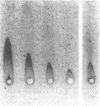Abstract
Heparin cofactor II is a plasma protein that inhibits thrombin rapidly in the presence of either heparin or dermatan sulfate. We have determined the effects of two glycosaminoglycan-binding proteins, i.e., histidine-rich glycoprotein and platelet factor 4, on these reactions. Inhibition of thrombin by heparin cofactor II and heparin was completely prevented by purified histidine-rich glycoprotein at the ratio of 13 micrograms histidine-rich glycoprotein/microgram heparin. In contrast, histidine-rich glycoprotein had no effect on inhibition of thrombin by heparin cofactor II and dermatan sulfate at ratios of less than or equal to 128 micrograms histidine-rich glycoprotein/microgram dermatan sulfate. Removal of 85-90% of the histidine-rich glycoprotein from plasma resulted in a fourfold reduction in the amount of heparin required to prolong the thrombin clotting time from 14 s to greater than 180 s but had no effect on the amount of dermatan sulfate required for similar anti-coagulant activity. In contrast to histidine-rich glycoprotein, purified platelet factor 4 prevented inhibition of thrombin by heparin cofactor II in the presence of either heparin or dermatan sulfate at the ratio of 2 micrograms platelet factor 4/micrograms glycosaminoglycan. Furthermore, the supernatant medium from platelets treated with arachidonic acid to cause secretion of platelet factor 4 prevented inhibition of thrombin by heparin cofactor II in the presence of heparin or dermatan sulfate. We conclude that histidine-rich glycoprotein and platelet factor 4 can regulate the antithrombin activity of heparin cofactor II.
Full text
PDF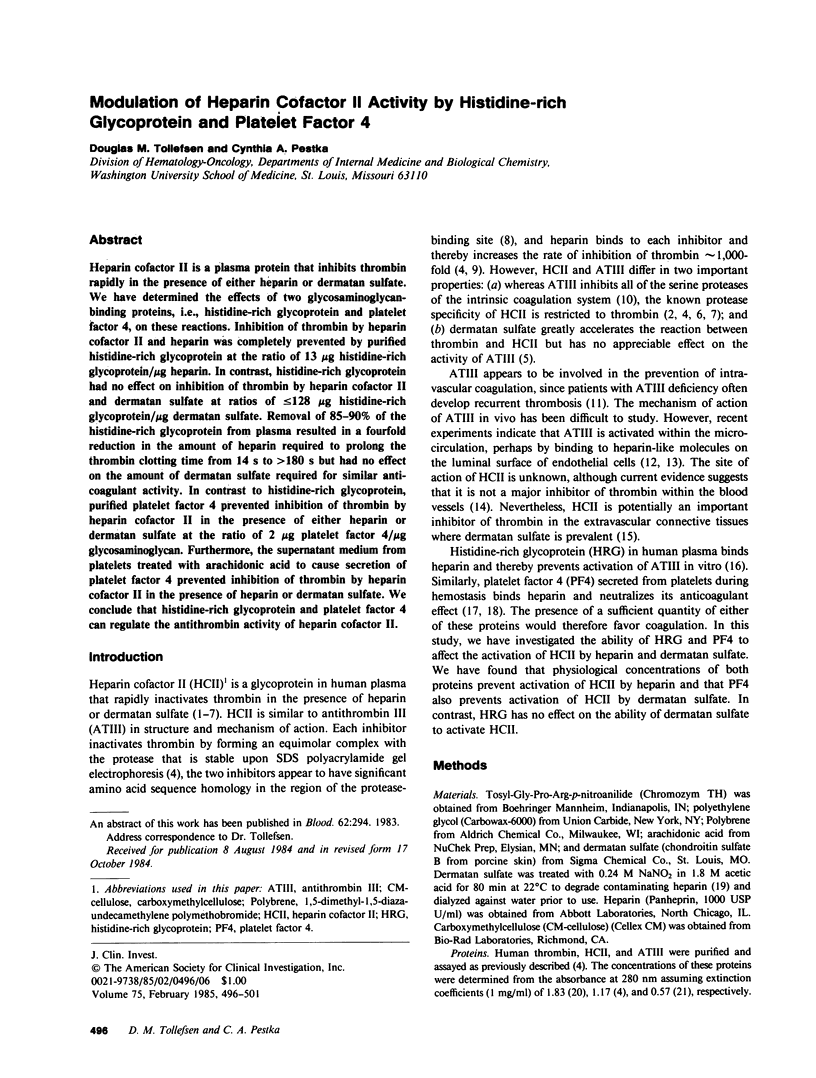
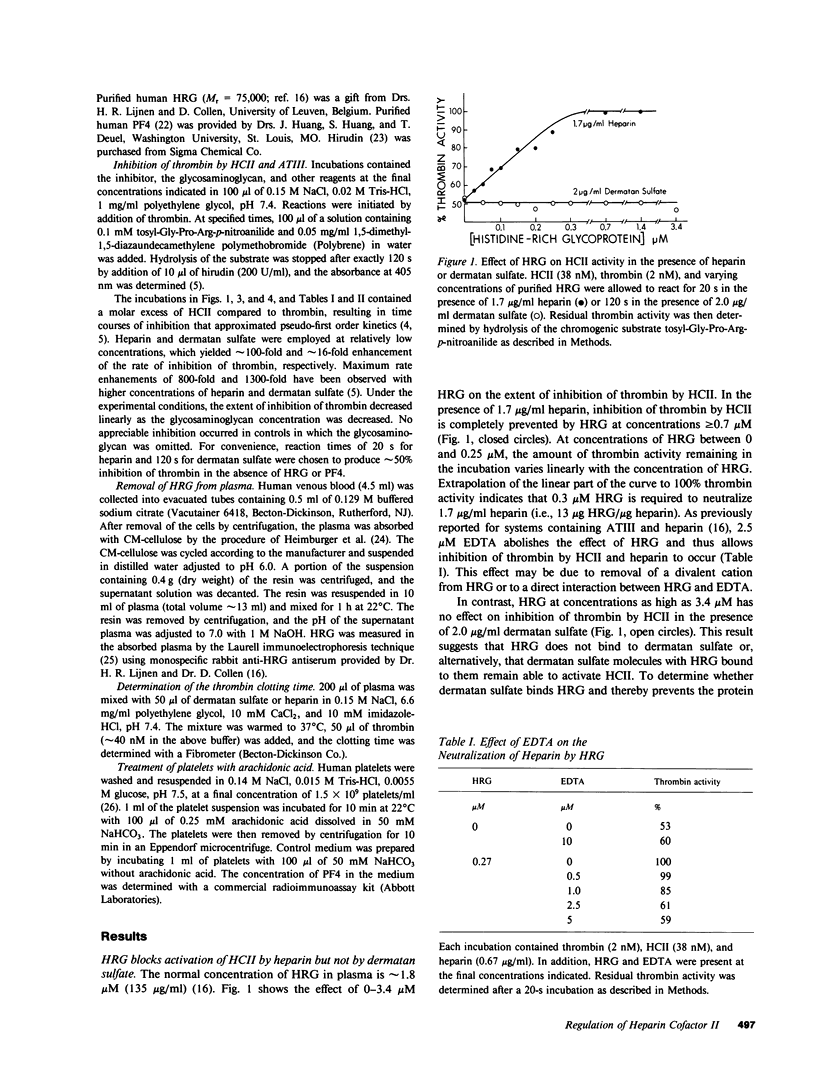
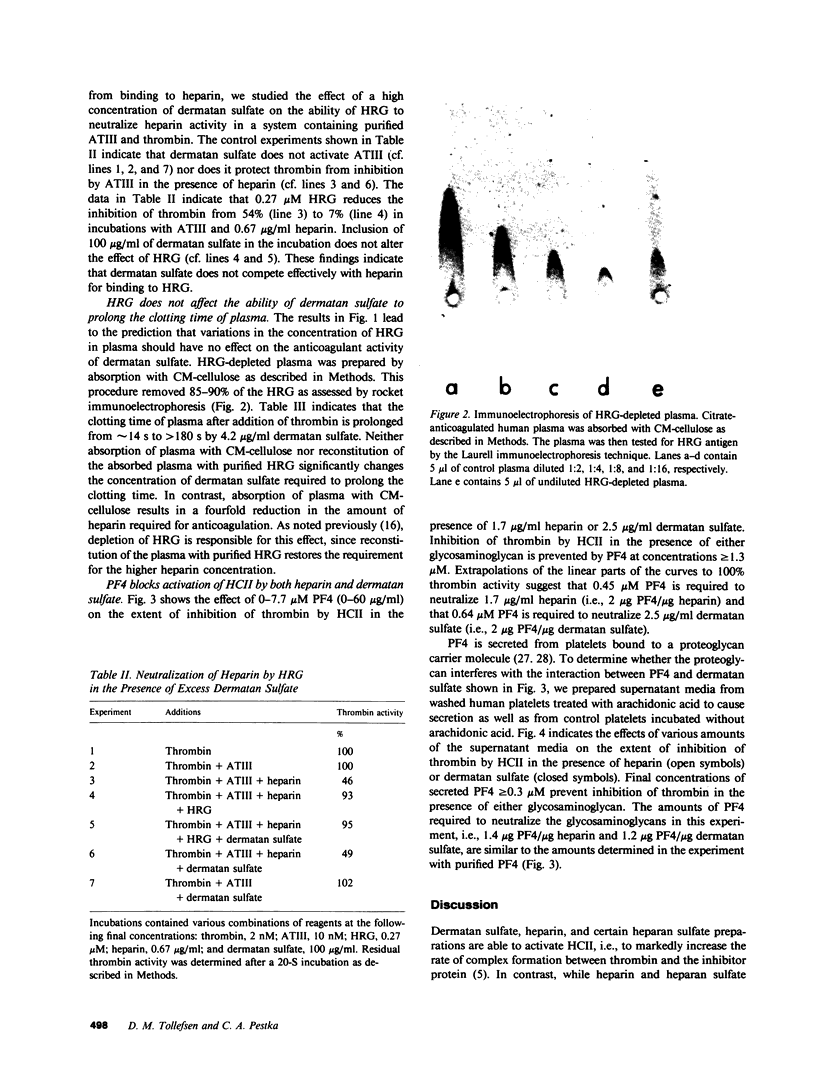
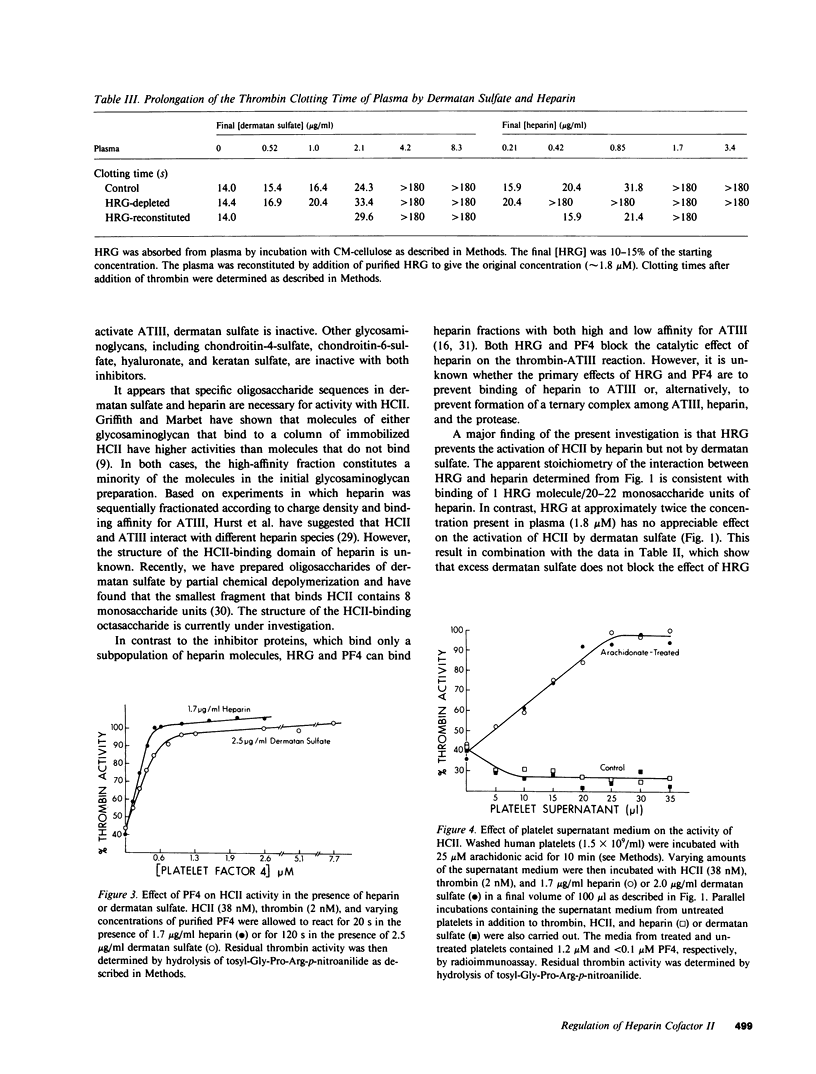
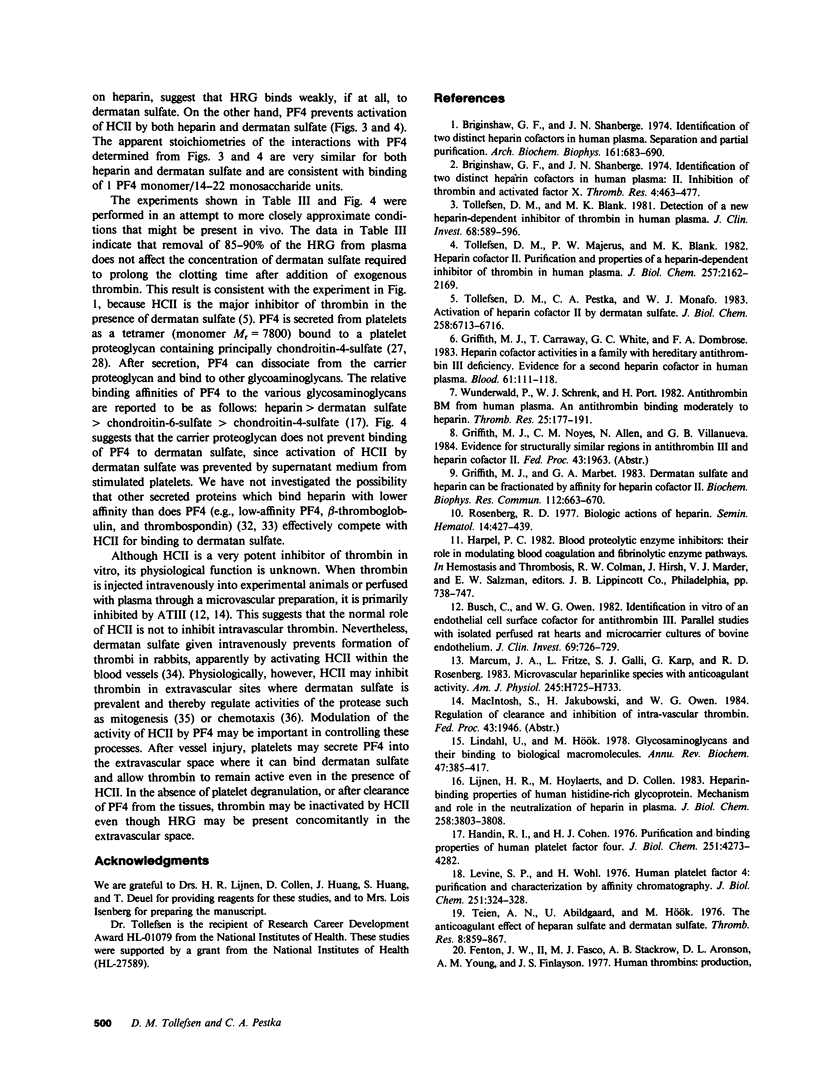
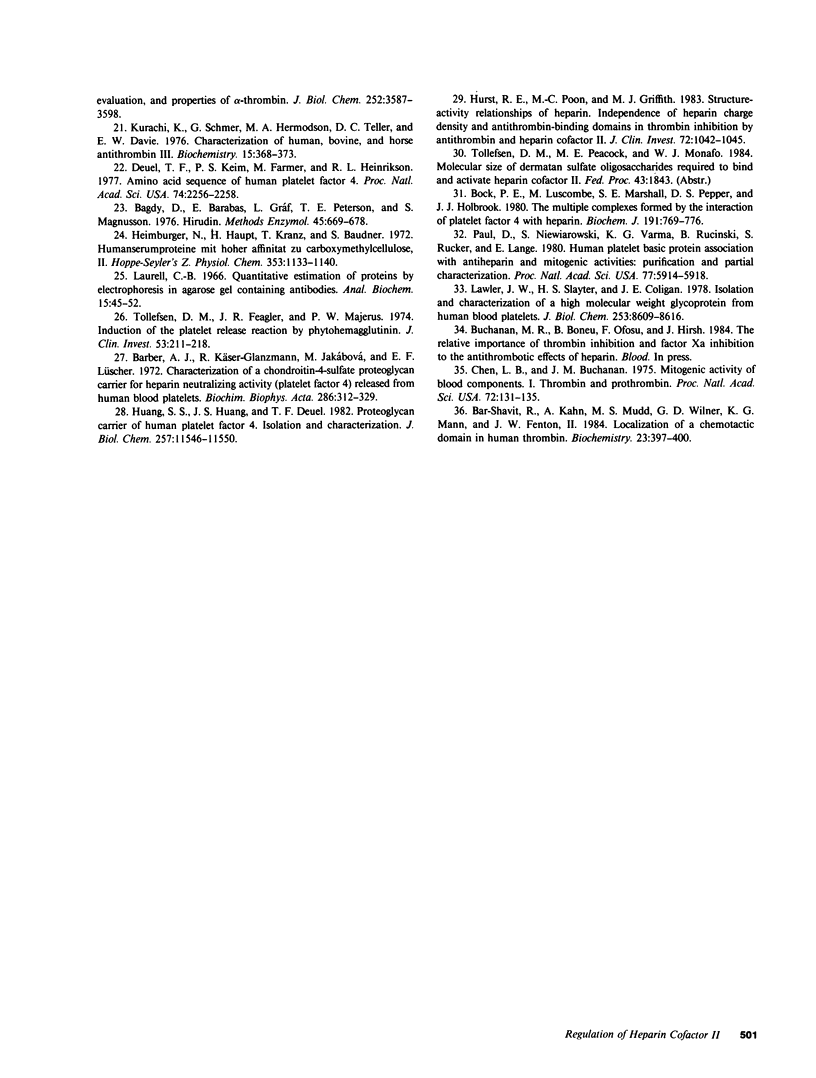
Images in this article
Selected References
These references are in PubMed. This may not be the complete list of references from this article.
- Bagdy D., Barabas E., Gráf L., Petersen T. E., Magnusson S. Hirudin. Methods Enzymol. 1976;45:669–678. doi: 10.1016/s0076-6879(76)45057-7. [DOI] [PubMed] [Google Scholar]
- Bar-Shavit R., Kahn A., Mudd M. S., Wilner G. D., Mann K. G., Fenton J. W., 2nd Localization of a chemotactic domain in human thrombin. Biochemistry. 1984 Jan 31;23(3):397–400. doi: 10.1021/bi00298a001. [DOI] [PubMed] [Google Scholar]
- Barber A. J., Käser-Glanzmann R., Jakábová M., Lüscher E. F. Characterization of a chondroitin 4 -sulfate proteoglycan carrier for heparin neutralizing activity (platelet factor 4 ) released from human blood platelets. Biochim Biophys Acta. 1972 Dec 29;286(2):312–329. [PubMed] [Google Scholar]
- Bock P. E., Luscombe M., Marshall S. E., Pepper D. S., Holbrook J. J. The multiple complexes formed by the interaction of platelet factor 4 with heparin. Biochem J. 1980 Dec 1;191(3):769–776. doi: 10.1042/bj1910769. [DOI] [PMC free article] [PubMed] [Google Scholar]
- Briginshaw G. F., Shanberge J. N. Identification of two distinct heparin cofactors in human plasma. II. Inhibition of thrombin and activated factor X. Thromb Res. 1974 Mar;4(3):463–477. doi: 10.1016/0049-3848(74)90081-4. [DOI] [PubMed] [Google Scholar]
- Briginshaw G. F., Shanberge J. N. Identification of two distinct heparin cofactors in human plasma. Separation and partial purification. Arch Biochem Biophys. 1974 Apr 2;161(2):683–690. doi: 10.1016/0003-9861(74)90354-3. [DOI] [PubMed] [Google Scholar]
- Busch C., Owen W. G. Identification in vitro of an endothelial cell surface cofactor for antithrombin III. Parallel studies with isolated perfused rat hearts and microcarrier cultures of bovine endothelium. J Clin Invest. 1982 Mar;69(3):726–729. doi: 10.1172/JCI110502. [DOI] [PMC free article] [PubMed] [Google Scholar]
- Chen L. B., Buchanan J. M. Mitogenic activity of blood components. I. Thrombin and prothrombin. Proc Natl Acad Sci U S A. 1975 Jan;72(1):131–135. doi: 10.1073/pnas.72.1.131. [DOI] [PMC free article] [PubMed] [Google Scholar]
- Deuel T. F., Keim P. S., Farmer M., Heinrikson R. L. Amino acid sequence of human platelet factor 4. Proc Natl Acad Sci U S A. 1977 Jun;74(6):2256–2258. doi: 10.1073/pnas.74.6.2256. [DOI] [PMC free article] [PubMed] [Google Scholar]
- Fenton J. W., 2nd, Fasco M. J., Stackrow A. B. Human thrombins. Production, evaluation, and properties of alpha-thrombin. J Biol Chem. 1977 Jun 10;252(11):3587–3598. [PubMed] [Google Scholar]
- Griffith M. J., Carraway T., White G. C., Dombrose F. A. Heparin cofactor activities in a family with hereditary antithrombin III deficiency: evidence for a second heparin cofactor in human plasma. Blood. 1983 Jan;61(1):111–118. [PubMed] [Google Scholar]
- Griffith M. J., Marbet G. A. Dermatan sulfate and heparin can be fractionated by affinity for heparin cofactor II. Biochem Biophys Res Commun. 1983 Apr 29;112(2):663–670. doi: 10.1016/0006-291x(83)91514-0. [DOI] [PubMed] [Google Scholar]
- Handin R. I., Cohen H. J. Purification and binding properties of human platelet factor four. J Biol Chem. 1976 Jul 25;251(14):4273–4282. [PubMed] [Google Scholar]
- Heimburger N., Haupt H., Kranz T., Baudner S. Humanserumproteine mit hoher Affinität zu Carboxymethylcellulose. II. Physikalisch-chemische und immunologische Charakterisierung eines histidinreichen 3,8S- 2 -Glykoproteins (CM-Protein I. Hoppe Seylers Z Physiol Chem. 1972 Jul;353(7):1133–1140. [PubMed] [Google Scholar]
- Huang S. S., Huang J. S., Deuel T. F. Proteoglycan carrier of human platelet factor 4. Isolation and characterization. J Biol Chem. 1982 Oct 10;257(19):11546–11550. [PubMed] [Google Scholar]
- Hurst R. E., Poon M. C., Griffith M. J. Structure-activity relationships of heparin. Independence of heparin charge density and antithrombin-binding domains in thrombin inhibition by antithrombin and heparin cofactor II. J Clin Invest. 1983 Sep;72(3):1042–1045. doi: 10.1172/JCI111028. [DOI] [PMC free article] [PubMed] [Google Scholar]
- Kurachi K., Schmer G., Hermodson M. A., Teller D. C., Davie E. W. Characterization of human, bovine, and horse antithrombin III. Biochemistry. 1976 Jan 27;15(2):368–373. doi: 10.1021/bi00647a020. [DOI] [PubMed] [Google Scholar]
- Laurell C. B. Quantitative estimation of proteins by electrophoresis in agarose gel containing antibodies. Anal Biochem. 1966 Apr;15(1):45–52. doi: 10.1016/0003-2697(66)90246-6. [DOI] [PubMed] [Google Scholar]
- Lawler J. W., Slayter H. S., Coligan J. E. Isolation and characterization of a high molecular weight glycoprotein from human blood platelets. J Biol Chem. 1978 Dec 10;253(23):8609–8616. [PubMed] [Google Scholar]
- Levine S. P., Wohl H. Human platelet factor 4: Purification and characterization by affinity chromatography. Purification of human platelet factor 4. J Biol Chem. 1976 Jan 25;251(2):324–328. [PubMed] [Google Scholar]
- Lijnen H. R., Hoylaerts M., Collen D. Heparin binding properties of human histidine-rich glycoprotein. Mechanism and role in the neutralization of heparin in plasma. J Biol Chem. 1983 Mar 25;258(6):3803–3808. [PubMed] [Google Scholar]
- Lindahl U., Hök M. Glycosaminoglycans and their binding to biological macromolecules. Annu Rev Biochem. 1978;47:385–417. doi: 10.1146/annurev.bi.47.070178.002125. [DOI] [PubMed] [Google Scholar]
- Marcum J. A., Fritze L., Galli S. J., Karp G., Rosenberg R. D. Microvascular heparin-like species with anticoagulant activity. Am J Physiol. 1983 Nov;245(5 Pt 1):H725–H733. doi: 10.1152/ajpheart.1983.245.5.H725. [DOI] [PubMed] [Google Scholar]
- Paul D., Niewiarowski S., Varma K. G., Rucinski B., Rucker S., Lange E. Human platelet basic protein associated with antiheparin and mitogenic activities: purification and partial characterization. Proc Natl Acad Sci U S A. 1980 Oct;77(10):5914–5918. doi: 10.1073/pnas.77.10.5914. [DOI] [PMC free article] [PubMed] [Google Scholar]
- Rosenberg R. D. Biologic actions of heparin. Semin Hematol. 1977 Oct;14(4):427–440. [PubMed] [Google Scholar]
- Teien A. N., Abildgaard U., Hök M. The anticoagulant effect of heparan sulfate and dermatan sulfate. Thromb Res. 1976 Jun;8(6):859–867. doi: 10.1016/0049-3848(76)90014-1. [DOI] [PubMed] [Google Scholar]
- Tollefsen D. M., Blank M. K. Detection of a new heparin-dependent inhibitor of thrombin in human plasma. J Clin Invest. 1981 Sep;68(3):589–596. doi: 10.1172/JCI110292. [DOI] [PMC free article] [PubMed] [Google Scholar]
- Tollefsen D. M., Feagler J. R., Majerus P. W. Induction of the platelet release reaction by phytohemagglutinin. J Clin Invest. 1974 Jan;53(1):211–218. doi: 10.1172/JCI107540. [DOI] [PMC free article] [PubMed] [Google Scholar]
- Tollefsen D. M., Majerus D. W., Blank M. K. Heparin cofactor II. Purification and properties of a heparin-dependent inhibitor of thrombin in human plasma. J Biol Chem. 1982 Mar 10;257(5):2162–2169. [PubMed] [Google Scholar]
- Tollefsen D. M., Pestka C. A., Monafo W. J. Activation of heparin cofactor II by dermatan sulfate. J Biol Chem. 1983 Jun 10;258(11):6713–6716. [PubMed] [Google Scholar]
- Wunderwald P., Schrenk W. J., Port H. Antithrombin BM from human plasma: an antithrombin binding moderately to heparin. Thromb Res. 1982 Feb 1;25(3):177–191. doi: 10.1016/0049-3848(82)90237-7. [DOI] [PubMed] [Google Scholar]



